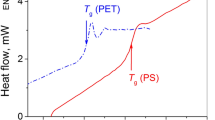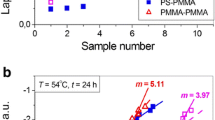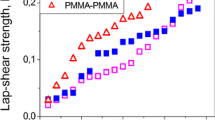Abstract
Films of amorphous polystyrene (PS) (mono- and polydisperse polymers) and poly(phenylene oxide) (PPO) were brought into contact at a low pressure (0.8 MPa) under temperatures T h from 62 to 156°C. The contact time t was varied from 2 min to 96 h. Partially “healed” PS-PS, PPO-PPO, and PS-PPO contacts were broken at room temperature and the shear strength in the contact zone was measured. The experimental σ-t curves were analyzed in double logarithmic coordinates. The value of for the three interfaces investigated was within 0.07-0.32 at T h < T g, where is the glass transition temperature. In the same way, the data on strength development taken from the literature for a number of polymer-polymer contacts formed both above and below T g were analyzed, and the range of variations in α proved to be roughly the same (0.05-0.35). The results obtained are discussed within the framework of theories of molecular dynamics for the polymer bulk and the interface.
Similar content being viewed by others
REFERENCES
R. P. Wool, Polymer Interfaces: Structure and Strength, Hanser Press, New York (1995).
P.-G. De Gennes, "Reptation of a polymer chain in the presence of fixed obstacles," J. Chem. Phys., 55, No. 2, 572–579 (1971).
K. Jud, H. H. Kausch, and J. G. Williams, "Fracture mechanics studies of crack healing and welding of polymers," J. Mater. Sci., 16, No. 1, 204–210 (1981).
S. Prager and M. Tirrell, "The healing process at polymer-polymer interfaces," J. Chem. Phys., 75, No. 10, 5194–5198 (1981).
M. Doi and S. F. Edwards, The Theory of Polymer Dynamics, Clarendon Press, Oxford (1986).
D. B. Kline and R. P. Wool, "Polymer welding relations investigated by a lap shear joint method," Polym. Eng. Sci., 28, No. 1, 52–57 (1988).
B.-R. Cho and J. L. Kardos, "Consolidation and self-bonding in poly(ether ether ketone)," J. Appl. Polym. Sci., 56, 1435–1454 (1995).
E. J. Vorenkamp, J. van Ruiten, F. A. Kroesen, J. G. Meyer, J. Hoekstra, and G. Challa, "Interdiffusion and adhesion of poly(vinyl chloride) and poly(methyl methacrylate)," Polym. Commun., 30, No. 4, 116–120 (1989).
Y. M. Boiko and R. E. Prud'homme, "Strength development at the interface of amorphous polymers and their miscible blends, below the glass transition temperature," Macromolecules, 31, No. 19, 6620–6626 (1998).
Y. M. Boiko and R. E. Prud'homme, "Morphology of Fractured Polymer Surfaces Self-Bonded Below the Glass Transition Temperature," Mech. Compos. Mater., 34, No. 5, 473–482 (1998).
D. R. Paul and S. Newman (eds.), Polymer Blends, Academic Press, New York (1978).
Yu. M. Boiko, "Initial stages of mixing compatible amorphous polymers with sharply different glass-transition temperatures," Vysokomol. Soed., 44A, No. 7, 1160–1167 (2002).
Y. M. Boiko, G. Guérin, V. A. Marikhin, and R. E. Prud'homme, "Healing of interfaces of amorphous and semi-crystalline poly(ethylene terephthalate) in the vicinity of the glass transition temperature," Polymer, 42, No. 21, 8695–8702 (2001).
S. M. Aharoni, "On entanglements of flexible and rodlike polymers," Macromolecules, 16, No. 11, 1722–1728 (1983).
V. A. Bershtein and V. M. Egorov, Differential Scanning Calorimetry in Physical Chemistry of Polymers [in Russian], Khimiya, Moscow (1990).
A. Karim, A. Mansour, G. P. Felcher, and T. P. Russell, "Short-time relaxation at polymeric interfaces," Phys. Rev. B, 42, No. 10, 6846–6849 (1990).
R. J. Composto, E. J. Kramer, and D. M. White, "Mutual diffusion in the miscible polymer blend polystyrene/ poly(xylenyl ether)," Macromolecules, 21, No. 8, 2580–2588 (1988).
H. Benoit, "Determination of polymer chain conformation in amorphous polymers," J. Macromol. Sci., Phys., B12, No. 1, 27–40 (1976).
H. R. Brown and T. P. Russell, "Entanglements at polymer interfaces," Macromolecules, 29, No. 2, 798–800 (1996).
A. Silberberg, "Distribution of segments near the surface of a melt of linear flexible macromolecules: effect on surface tension," J. Colloid Interface Sci., 125, No. 1, 14–22 (1988).
G. S. Y. Yeh and P. H. Geil, "Crystallization of poly(ethylene terephthalate) from the glassy amorphous state," J. Macromol. Sci., Phys., B1, No. 2, 235–249 (1967).
Yu. M. Boiko, "Minimum bond strength of polymer surfaces at a low-temperature short-term contact," Vysokomol. Soed., 42B, No. 3, 542–545 (2000).
Author information
Authors and Affiliations
Rights and permissions
About this article
Cite this article
Boiko, Y.M. Relationship between the Contact Time of Polymer Surfaces and Their Bond Strength. Mechanics of Composite Materials 39, 89–98 (2003). https://doi.org/10.1023/A:1022995807693
Issue Date:
DOI: https://doi.org/10.1023/A:1022995807693




